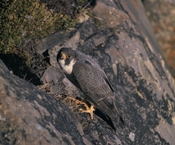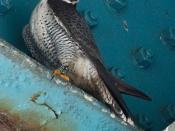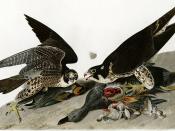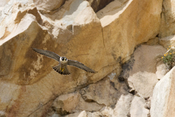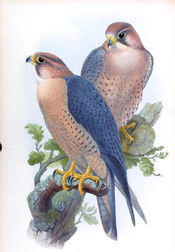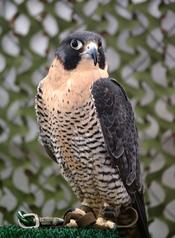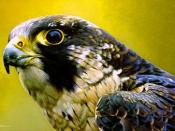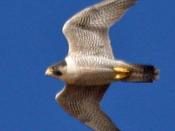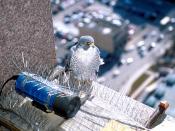6B The Peregrine Falcon By Jon Schellenberg
The Peregrine Falcon
(Falco peregrinus)
By Jon Schellenberg 6B
November 2005
Intro
The peregrine falcon is the fastest animal in the world. It is mainly known for its high-speed dives and its amazingly swift kills. Its distinct features and deadly claws and talons grabbed my attention immediately. The peregrine is a 'raptor', or a bird of prey. It is an endangered species, so it is our responsibility to protect these spectacular birds from poachers and predators. The following report is about this amazing creature.
Description
The front of its neck is white, and its entire underside is pale and cross-barred with dark brown. On its back are blue feathers striped with grey and its tail feathers are long and are tipped with white. The average peregrine's wingspan is about forty inches. The wings are swept back to cut through the air so that they can fly fast. Their bare yellow legs are attached to sharp, curved talons that are used for killing prey.
Habitat
Peregrines are found in every continent except Antarctica. They are found in Canada, but are not common anywhere. There are supposedly twenty-two sub-species, but only three are found in North America.
Peregrines' nests are called 'scrapes'. These birds like high ground so some have adapted to city life to live on skyscraper ledges. Others live on cliff outcrops. They clear any debris away until their space is completely clean.
Food
Peregrines eat other things that fly, like ducks, pheasants and pigeons. Sometimes they'll even eat blackbirds and bats! An adult will eat an average of seventy grams of food per day. That's equal to two whole blackbirds!
Enemies
Peregrines are an endangered species. They became endangered when a pesticide called DDT entered the food chain in the '50s and '60s, killing hundreds. But in remote areas, main predators include the Great Horned owl and martens. Also, peregrines are threatened by poachers and egg collectors.
Attack
Young
The mother usually has three or four eggs at a time. The eggs are slightly smaller than chicken eggs and are dark reddish-brown. The mother does most of the incubating which sometimes takes up to thirty-three days. When the female takes off to feed, the male will incubate. Peregrine nestlings are called 'eyases'. The new eyases weigh about two ounces and are covered with soft white down feathers. Eyases eat an incredible amount of food. After six days, they have doubled their weight since birth. At three weeks, they are ten times their birth size. At four weeks, their down is replaced by feathers. When they are forty days old, they start learning to fly when the parents bait them with food. After learning to fly (also called fledging), the eyases depend on the parents for about four weeks. As they gradually grow more independent, they fly away and leave the area that they were born. Sixty per cent of eyases will die in their first year of birth. If they are lucky enough to survive year one, they establish a territory elsewhere. After maturing a bit, they will have darker, browner plumage, and vertical brown streaking on their breast. Their feet will be a pale yellowish-grey.
Interesting Facts
In level flight, peregrines can fly over 100 kph!
They can live to be fifteen years old!
If a mate dies, the survivor will mate again in less than a week!
Some peregrines migrate, and some don't!
The word 'peregrine' means 'wanderer' in Latin!
Peregrines have excellent eyesight!
The peregrine has very quick but powerful wing beats!
Peregrines are much more agile than other raptors!
When excited, the peregrine will bob its head and wag its tail feathers!
Female peregrines are sometimes up to 50% larger than males!
Peregrine moustaches, or malar lines, are like human fingerprints: no two are the same!
One of the peregrine's sub-species lives in the Arctic!
When peregrines soar, they stretch out their wings and tail feathers so their tail has the appearance of a diamond!
A peregrine's dive is also called a 'stoop'!
When in a stoop, they fold their wings in completely!
Fighter plane designers have copied the peregrine's wing shape for their aircraft!
Because the female is so much larger than the male, the male often approaches cautiously and bows in submission to her!
The female often incubates through the entire night!
Two eyases would rarely hatch on the same day!
Captive peregrines tend to live much longer than wild ones, sometimes ranging from twenty to twenty-five years!
A typical peregrine family will eat around five hundred pounds of food a year!
A male peregrine is referred to as a tiercel and the female is referred to as a falcon!
Tiercel means 'one-third', because males are usually one third smaller than females!
In Canada, it is illegal to kill or disrupt a peregrine in its nesting area!
The peregrine has been endangered for thirty-three years (since 1972)!
'Falconry' is a sport popular in the Middle East. People train raptors, then use them in competitions!
A peregrine can turn its head 360ÃÂ because they have many more vertebrae than mammals!
Outlook for the Future
Because peregrines are so rare, I certainly hope that we can take charge and protest against the poachers and other threats to help save this falcon. I hope that in the future people will be more responsible, because at this rate, in a thousand years, every kind of animal will be extinct! We need to help the falcons breed in zoos and parks so that there will be enough to return to the wild again. Then, once more they will be plentiful in all the countries of the world, living free, like all creation should be.
Bibliography
Birds of Prey
by Robin Kerrod
http://raysweb.net/specialplaces
www.peregrine-foundation.ca/biology
www.dnr.ohio.gov/wildlife/falcons/faq
Images
images.google.ca
�PAGE � �PAGE �- 9 -�
